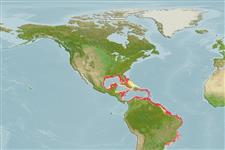Common names from other countries
Environment: milieu / climate zone / depth range / distribution range
Ekologi
laut dasar (demersal); kisaran kedalaman 20 - 150 m (Ref. 5217). Subtropical; 30°N - 26°S, 98°W - 34°W
Western Atlantic: northwestern Gulf of Mexico to Brazil.
Size / Weight / umur
Maturity: Lm ? range ? - ? cm
Max length : 32.0 cm TL jantan/; (Ref. 5217); common length : 25.0 cm TL jantan/; (Ref. 3275); Berat maksimum terpublikasi: 371.30 g (Ref. 128822)
Duri punggung (Keseluruhan (total)) : 0; duri punggung lunak (Keseluruhan (total)) : 82 - 90; Duri dubur: 0; Sirip dubur lunak: 63 - 69. Body is oval, moderately elongate. Dorsal fin originates distinctly anterior to a vertical at front of the eyes. Eyes on left side, not large, their diameter is 5 - 5.9 times the head length. The interorbital space is narrow, less than half the eye diameter. Lateral line on eyed side is not steeply arched above pectoral fin. The mouth is large extending slightly beyond the posterior margin of the eyes. Caudal fin is rounded. Color is brown with a large blotch beneath pectoral fin. The dorsal and anal fins have a row of dark spots containing pale areas,. Two spots on the dorsal and a few on the anal are large. The caudal fin has three large dark spots at the posterior border, none on center of the fin. Number of ovaries: 2. Ovaries are symmetrical, lie parallel with each other, depressed cross-sectionally and extra-visceral in location (Ref. 101557).
Occurs in bays, lagoons and shallow coastal waters. Found on soft bottoms (Ref. 5217). Marketed fresh (Ref. 5217).
Life cycle and mating behavior
Maturities | Reproduksi, perkembang biakan | Spawnings | Egg(s) | Fecundities | Larva
Distinct pairing (Ref. 205). Number of ovaries: 2. Ovaries are symmetrical, lie parallel with each other, depressed cross-sectionally and extra-visceral in location (Ref. 101557).
Robins, C.R. and G.C. Ray, 1986. A field guide to Atlantic coast fishes of North America. Houghton Mifflin Company, Boston, U.S.A. 354 p. (Ref. 7251)
Status IUCN Red List (Ref. 130435)
CITES (Ref. 128078)
Not Evaluated
ancaman kepada manusia
Harmless
penggunaan manusia
Perikanan: nilai komersial kecil
Alat, peralatan
laporan khas
muat turun XML
Sumber internet
Estimates based on models
Preferred temperature (Ref.
115969): 19.6 - 27.4, mean 24.8 (based on 192 cells).
Phylogenetic diversity index (Ref.
82804): PD
50 = 0.5625 [Uniqueness, from 0.5 = low to 2.0 = high].
Bayesian length-weight: a=0.00891 (0.00405 - 0.01963), b=3.11 (2.93 - 3.29), in cm Total Length, based on LWR estimates for this (Sub)family-body shape (Ref.
93245).
Trophic level (Ref.
69278): 3.6 ±0.2 se; based on size and trophs of closest relatives
Daya lenting (Ref.
120179): Tinggi, Waktu penggandaan populasi minimum kurang dari 15 bulan (K=0.78).
Fishing Vulnerability (Ref.
59153): Low vulnerability (20 of 100).
